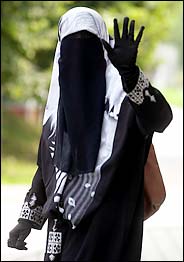To veil or not to veil?
 REZZO, Italy - The immediate issue is how one woman in one tiny town in northern Italy dresses, so it made a certain kind of sense for Giorgio Armani to weigh in. His opinion? A woman should wear what she likes, even if what she likes is a veil that hides her face completely. "It's a question of respect for the culture of others," Mr. Armani, the fashion designer, said in a statement released late last month. "We need to live with these ideas."
REZZO, Italy - The immediate issue is how one woman in one tiny town in northern Italy dresses, so it made a certain kind of sense for Giorgio Armani to weigh in. His opinion? A woman should wear what she likes, even if what she likes is a veil that hides her face completely. "It's a question of respect for the culture of others," Mr. Armani, the fashion designer, said in a statement released late last month. "We need to live with these ideas."He was speaking out in defense of Sabrina Varroni, a Muslim woman from this town near the Swiss border who has been fined 80 euros, about $100, for appearing twice in public wearing a veil that completely covered her face. Her punishment has won cheers from some Italians and has horrified others.
Mr. Armani's views were just one of the particularly Italian twists to questions facing much of Europe over its uneasy relationship with Islam.
The case of Ms. Varroni is not a simple one about religious freedom. Drezzo, population 1,800, is controlled by the Northern League, a political party in Prime Minister Silvio Berlusconi's governing coalition that has advocated the secession of northern Italy and strict controls on immigration.
The case has been viewed by some as a telling clash of two ideologies: Islam versus Italian xenophobia.
To fuel that view, the mayor here, Cristian Tolettini, fined Ms. Varroni under a 1931 Fascist-era law banning the wearing of masks in public.
The Italian press got into the act when a reporter from the Milan newspaper Il Giorno showed up in Drezzo last month completely veiled, and was promptly fined, too.
Ms. Varroni, 34, a mother of four, is not one of the thousands of poor Muslims who have immigrated legally to Italy in recent years to seek a better life, or among the thousands more who have arrived illegally. She is a native Italian who grew up in Drezzo and married a Tunisian more than 10 years ago, converting to Islam.
Late last month, she wrote an impassioned letter to the Italian president, Carlo Azeglio Ciampi, complaining of threats to her and her family and begging for help.
"I'm scared of the violence that this unwanted publicity will seek out," she wrote. "I've never tried to proselytize, or use my veil as a provocation. What harm am I doing? I am not masked. I'm simply wearing a veil that is obligated by my faith."
Similar arguments have been made by female students in France, Germany and Turkey, which restrict the wearing of a less severe symbol of Islam, the head scarf, in schools.
In June, the European Court of Human Rights rejected an appeal by a Turkish student, saying such laws "can be justified" to prevent fundamentalist groups from pressuring women to wear such symbols.
The problem in Drezzo, which has a handful of Muslim immigrants, started two years ago when Ms. Varroni showed up at the town hall, wearing a veil that covered her entire face. In a telephone interview, she said she began wearing the veil, called a nikab, about five years ago.
"I wear the veil because it is a law," she said. "It is an obligation of my faith."
The mayor saw it differently.
"I was stupefied," Mr. Tolettini, then the deputy mayor, recalled. "We have a lot of Muslims who live here, and they don't dress like that."
He asked her to show him her face so that he could identify her. She said, according to Mr. Tolettini, that she would reveal her face only to a woman. Mr. Tolettini said he decided to let it go, but warned her that laws prohibited appearing in public with a concealed face.
No problems occurred until July 2004, when she went to the town hall again and Mr. Tolettini, now the mayor, was there.
"My authority and my duty was to have her identified," he said. "She clearly refused."
The laws Mr. Tolettini cited are in dispute. Italy has two such laws, neither of which anticipated the issue of Islamic dress codes: one from 1931, under Mussolini's Fascist rule, and another, enacted in 1975 when fear of the Red Brigades guerrilla group was high, forbidding disguises that mask a person's identity.
Labels: culture, muslim women, veil


0 Comments:
Post a Comment
Subscribe to Post Comments [Atom]
<< Home